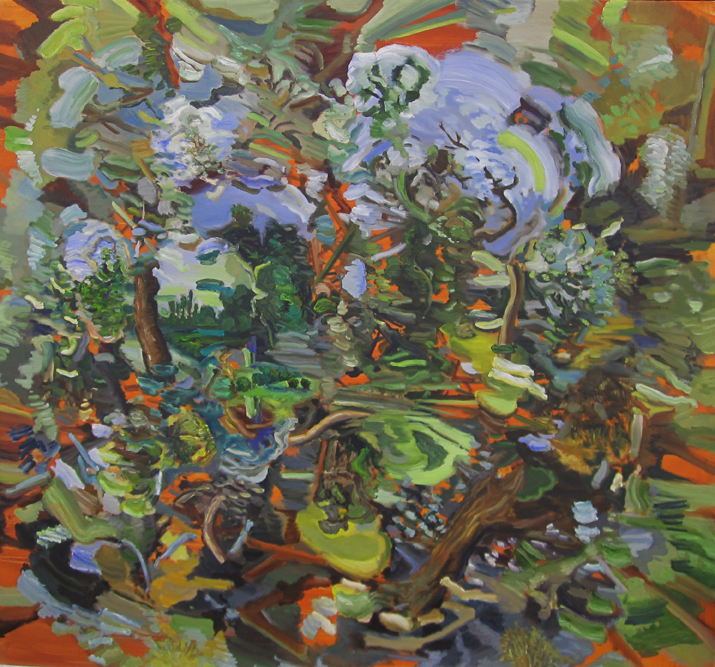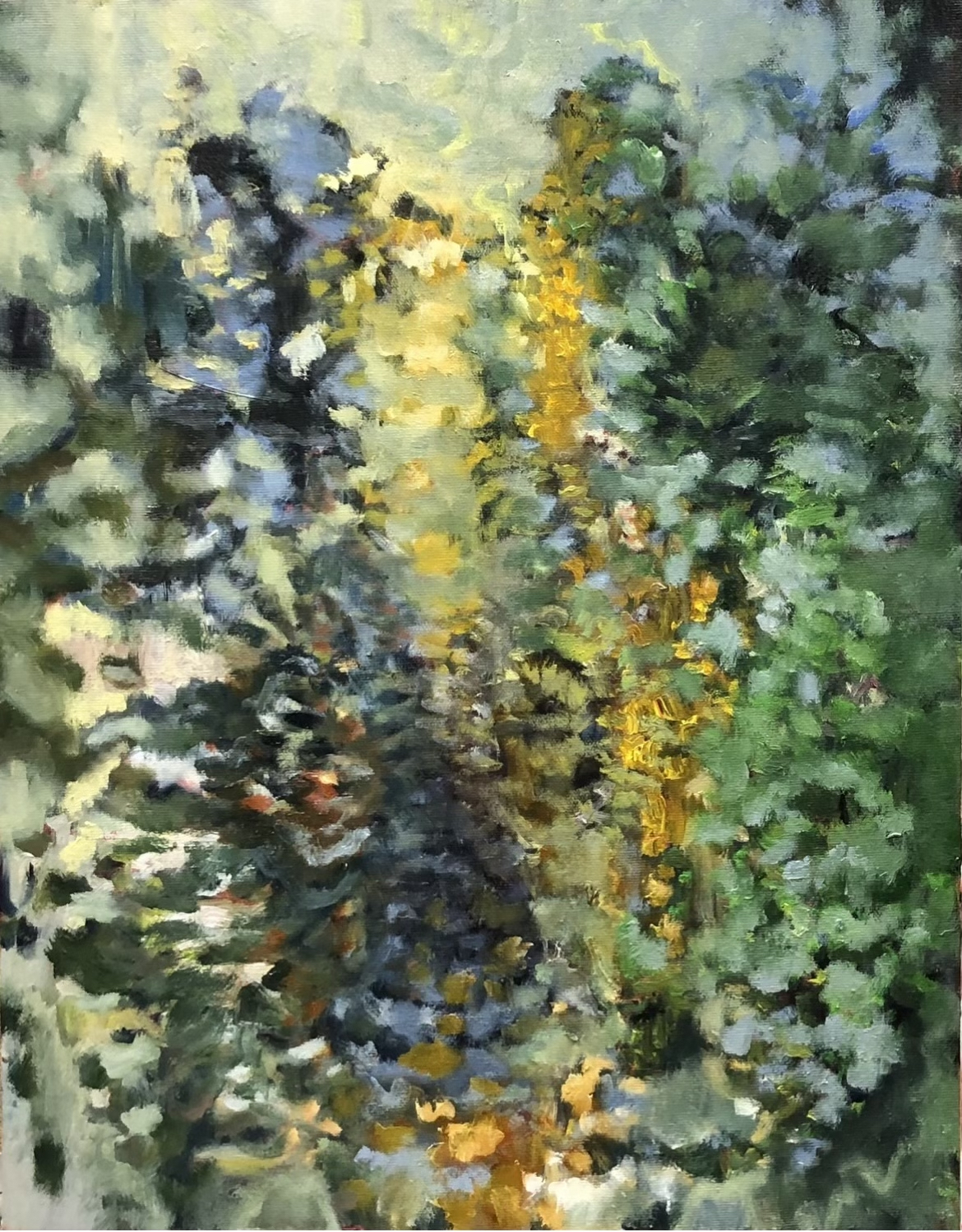Ghost Host
Gary Evans
paintings and paper collage
July 17 - August 15, 2015

Ghost Host
The work in Ghost Host comes from two different groups of imagery and media. The process of constructing the imagery however shares some common attributes: both are additive processes that start with fragmented sources. In the case of the paintings, small isolated areas of the landscape are recombined to create a sense of unique space and presence. In the collage work, imagery with inherent texture and photographic detail become edited shapes or fragments with a sense of their own shape identity, combined to create new imagery.
The paintings are inspired by historic reference points but combine painted elements derived from a variety of source material. My main intention is to create an underlying feeling, where one place with obviously physical exterior familiarity represents in a masquerade of sorts something psychological, a thought or sensation with its own sensibility. I like the idea that two or more things are going on simultaneously, objectivity being shaped and given new structure by the subjective. The structural aspect of composition resolving, binding and freezing in place. Although the paintings are full of flux and movement I also hope that a static balance is a recognizable point of entry into the simultaneity of image and mystery.
The collages are driven by a sense of drawing through editing and cutting. The availability of printed colour, it’s quality and ubiquity, lend the collages a different sensibility. However, the formal sensations I hope to evoke are similar to those in the paintings. What manifests itself is thankfully less controlled as the context of one shape against or over another creates novelty and spatial anomalies. That is for me the engaging process decided through the arranging that happens before the gluing.
When I initially started this process I would carefully excise shapes from pictures with a knife leaving the page in the magazine. I was struck by how the remaining combinations revealed an underlying image far superior in a way to the constructed image I was making in white space. I realized at that point our expectations of collage are often predicated on it making random and unsettling or uncanny juxtapositions. In this way I actually feel that these collages are better described as a process of montage, with the specifics of form and the sense of photographic space and texture being composed in a very purposeful manner. The vibrancy that [I hope] they achieve comes from the juxtaposition of flatness, in both the white space and the magazine surface, against the form found in both the volume depicted in imagery and the identity of the shape and outline.
It is the mystery of perceived movement that these montage works suggest which I find compelling; the sense of presence in the fabrics and shapes that speak of structure, like some great apparatus that has held them in place has suddenly disappeared and we see the impressions and tensions left behind. This idea of an inherent yet mysterious structure is the inspiration for the show’s title and hopefully the link between the two bodies of work.
-- Gary Evans, June 2015
Gary Evans was born in Weston Super Mare, England and resides in Alliston, Ontario. He has been exhibiting at PPCA since 1995. Evans' work in contemporary painting challenges traditional notions of perception and experience of the Canadian landscape. Of his more than 20 solo exhibitions highlights include a touring exhibition of his work, Seeing Things: The Paintings of Gary Evans, curated by Stuart Reid, which toured Canada between 2000-2002 as well as a survey of paintings, Station, at The Art Gallery Of Windsor in 2008. A new 15-year survey is currently in co-partnership development with the MacLaren Centre and Rodman Hall Art Centre.
Evans is a graduate of the Ontario College of Art and Design and is an instructor at the School of Design And Visual Art, Georgian College, Barrie, Ontario.
Into the Woods and Beyond with Gary Evans, Paul Petro Contemporary Art, Toronto, July 17 to August 15, 2015
by Richard Rhodes
Gary Evans has been painting up a storm since the late 1980s. A longtime denizen of Paul Petro Contemporary Art, Evans has presented himself in show after show as an inventive colourist possessed by an equally inventive take on landscape painting. That take often results in scenes of confounding density, which, with observer patience, settle into rich, combinative sequences of descriptive paint that pay homage to landscape in terms of not just spatial experience, but also in terms of accrued personal memory and passing real time.
Twisting noodles of brushed paint firm up a scenic space around this perceptual volatility. The brushstrokes duck and weave between those experiential planes as manifestations of pure viscous paint, gesture, local colour and shifting points of perspective. If Harold Klunder and Ben Reeves have competition in the realm of impacted pictorial surface, it is Evans.
His new show at Paul Petro delivers a trio of oil paintings from 2014—At the mouth of the woods, Sound Hole and Daydream—that show Evans at his intensive best. At the mouth of the woods brings a sense of spinning peripheral vision to a forest scene that deepens and deepens as you look. Skeins of paint, delicately brushed in terms of blended pigments, leave gaps that open onto colour spaces beyond. The bottom layer has a pushback warmth that reads like reachable sunlight. It is hard not to think of the whole enterprise—from image to title—as a working metaphor for Evan’s complicated procedural painting practice. Every painting entails a sense of arrival, of moving through paint towards something beyond it.
What a surprise, then, to see the paintings surrounded by numerous new collage works made this year. The suggestive depths of the paintings disappear in favour of graphic flatness as Evans cuts out colour samples, clothing items and clothed body fragments from fashion magazines and pastes them into new clusters that engage in a playful dialogue with the surrounded and surrounding white space. Each has its own suggestive title that opens up the interpretive field of the collage. They are not unrelated to Geoffrey Farmer’s sculptural transmutations of picture content, where image space is delivered as if it bears implicit volume and real-world materiality. The more one looks, the more one thinks that Evans is chasing the brushstrokes he left behind and the directional energy they lent to reading the surfaces of the paintings. Each collage becomes a compound of textural and directional energies of the clipped fashion photos. The title of the show, Ghost Host, aims at those gathered reverberations. It tells us that Evans has found new fields to harvest.
Richard Rhodes, 4 August 2015, www.canadianart.ca



